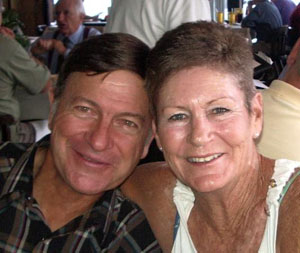
East coast USA & St Louis, MO

September
15 - 19: Punta Gorda,Florida. Robin & Nigel Morris
Having
heard horror stories of the tough new US immigration procedures, I was
apprehensive at Miami, but I had a splendid reception, helped by my having a US
passport. The genial immigration officer glanced at me, looked down at my
passport and said “I did a double take… you are pretty good for your age. Welcome back”. From Miami a short
flight to Fort Myers, where Robin's husband Nigel met me to drive me (one-hour)
to their home .
On
the way I was intrigued to see a new roadside sign, Panther crossing 45 mph, 40 at night.
Nigel told me that there are still a few panthers around but several had been
killed by speeding motorists.
I
received the warmest welcome ever from my niece Robin, Paul's eldest daughter,
who was to celebrate her 60th birthday the next day - obviously a factor when I
arranged my itinerary. Rob and I have always been close. Three of Rob and
Nigel's four children were present - Rhett, 29, a professional fisherman who
lives a half mile down the road; Bruce, 27, also a professional fishermen who
has his own house in town; Kym and her husband Greg and their little baby
Bryland were visiting from South Florida. Chace (see Aug. 29) was in England. I
had last seen Rob and Nigel, Rhett and Kym, in February 2006, when they came to
KwaZulu /Natal for our family reunion. The house, on a double plot, is located
a few miles outside of the town of Punta Gorda, a city on the gulf coast, which
was the epicentre of Hurricane Charlie in August 2004. During my short stay I
saw much evidence of the destruction
After
a heavy shower of rain it was decided to have the party in the barn, which had
to be cleared out and tidied up. I borrowed Rob’s car to drive to the 5:30pm
Mass (dull) in town, returning in time for the merry birthday party - the
family had obviously become very popular amongst the locals and there was a
scattering of old friends from Rhodesia: Rob & family moved from Rhodesia
in 1979, just before Independence for Zimbabwe. The highlight of the party was
a very moving speech given by Rhett to honour his mum. The party continued to
the small hours but I was in bed by midnight.
The next morning, I set off on a walk but I soon found that my wrists and ankles and face were covered with mosquito bites and in addition the heat and humidity were unpleasant, so I retreated to the air-conditioned interior. In the cool of the evening Nigel took us for a drive in his “buggy”, through the palmettos, accompanied by his excited pointers, which he keeps for his favourite sport of hunting quail in the winter. For supper we had halibut and smoked salmon which Rhett had caught on a holiday in Alaska and frozen; Bruce, as well as being a fisherman, is a keen bow hunter and often hunts deer in Georgia where the deer population has multiplied and culling is essential.
The next day Rhett took his
mum and me out in his neat and efficient fishing boat, impressing me with his
knowledge not only of the fish and the tides and the waterways but also of the
birds, quickly identifying, even from a distance, osprey, bald eagle, frigate bird, terns and
cormorants. Rhett – and my other great-nephews and great-nieces – fill a similar
place in my life, and my heart, as do grand-children for my friends who are
grand-parents. After a final breakfast at Smokey Joe's with the family, Rob
drove me to Fort Myers for flights to Washington DC and on to Syracuse, New
York.
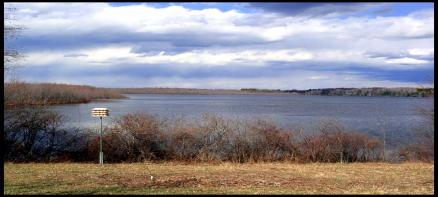 Beaver Lake, NY
Beaver Lake, NY
September 19 – 28, upstate
New York, with three separate families.
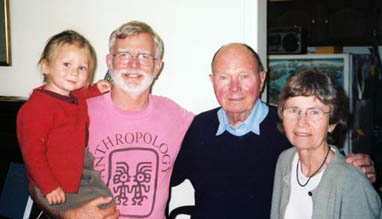
Indigo,Garry,DWB &
Connie
September 19/20 & 22/23
Ithaca, N.Y. Garry & Connie Thomas, met me at
Syracuse airport; we had first met in March 1968 when they were graduate
students at Syracuse University, which was then, under the dynamic leadership
of the redoubtable Fred Burke, a major centre for East African Studies. In
preparation for a research trip that summer I had gone to Syracuse University
(SU) to meet colleagues and to check the archives. Garry had been assigned to me
as my “minder”. We came together again in the 1970s through our mutual interest
in fuelwood in East Africa, and in 1984 Garry and I directed a Social Forestry
workshop in Malawi, for FAO. When we were living in England in the 1990s we
several times saw G & C whose two daughters, Carla and Katrina, had each
married British horticulturalists and were living in England. There was the
pull of adored grand-children. In addition Bernard and I had stayed with G
& C first in Strasbourg, 1985, and later, 1992, in Rome. Garry and Connie
recently retired from many years teaching (anthropology and French,
respectively) at Ithaca College, a good liberal arts college, with 6,200
students.
Here
are some of the contrasts I noticed:
| Punta Gorda | Ithaca
|
Hot
and humid
|
Cool,
signs of Fall
|
Flat
landscape, palmettos
|
Rolling
hills, gorges
|
New
housing, trailers
|
Gracious
old homes
|
A
“red” Republican State
|
-
“10 Sq Miles surrounded by reality”
|
An
ageing population
|
A
college town, young
|
Hunting,
shooting and fishing
|
Organic
markets
|
When
I accompanied G & C to the Green Star Co-operative market, I noticed that -
on ethical grounds - no Chinese products were stocked, but South African goods
were now acceptable, a change since the last time I had been in the US.
G
& C are also keen walkers and what wonderful walks we had, particularly in
the famous Ithaca Gorges, which combine dramatic scenery with a few challenging
climbs. They identified the towering trees - Norway and sugar maples, birch,
black and yellow hemlock and red cedar. Trees were beginning to turn, but it
was about two weeks too early for the true glory of the Eastern Fall. We also
walked around the campus of Cornell University. Ithaca is a lively college
town, with five bookshops, umpteen ethnic restaurants (we had dinner in a fine
Thai place) and a good buzz. But Garry told me that excessive drinking,
especially at the fraternity houses near their home, is a problem. I saw many
students from South and Southeast Asia, but comparatively few African-Americans
or Hispanics.
Although
they are retired, G and C remain active in many ways, particularly as active
Quakers, bearing peaceful witness against war and speaking out against the
(often unconstitutional) actions of the Bush administration - sometimes at
considerable risk: I met their friends, one of whom had been imprisoned because
of his protest. Garry continues to be involved professionally in Anthropology,
while Connie has a full schedule including yoga, a classics class, singing in
the choir (preparing for Schubert's Mass) and teaching ESL four mornings a week
to refugees and immigrants. Connie is also a volunteer for the Friends of
Ithaca library, which twice a year has one of the biggest book sales in the US,
as I saw when Connie showed me the huge warehouse where they were preparing for
the sale the following week. In addition she often looks after two year-old
Indigo, her bonny grandson; Indigo’s father, Caleb, whom Bernard and I had
first met as a bright eight year old in Strasbourg, was away harvesting medical
marijuana in California - his major source of income for the year. Caleb and
his partner Sareanda, who is a doula (a person who helps women in childbirth) are vegans, activists for peace,
determined to “leave light footprints” and to follow an alternative lifestyle.
However, I noticed that Caleb’s parents provide essential support in many ways.
After
my first night in Ithaca, I was due to go to Binghamton, an hour's drive away.
Being over 75 years of age, I could not rent a car, so Garry offered me their
old Volvo, but I sensibly declined, choosing instead to go by Greyhound bus;
this was fast, relaxing and comfortable, giving me a chance to admire the early
fall colours, the sumacs and the trim American homes.
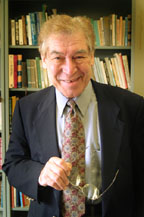 MichaelHorowitz
MichaelHorowitz
September 20/22 Binghamton
NY, Michael & Sylvia Horowitz. Michael and I met
in 1977 when he and I and Ted Scudder (see October 9/11) founded the
not-for-profit Institute for Development Anthropology (IDA) on which we worked
closely together for 15 years. We often had our directors' meetings at or near
Binghamton, where Michael had an appointment at the State University of New
York.
Although
Michael had suffered some memory loss, he was cheerful and relaxed as he drove
us around town. We celebrated Rosh Hashanah with their son Andrew and his
family. I had known Andrew as a young man making his living as a dancer; now he
is still ,at age 46, dancing - with “The Galumpha Trio”. Judging by a video
this is a very professional group and has had national and international success.
One
of my reasons for visiting Binghamton was to check IDA archives for a history
of IDA which I was contemplating writing. Michael's daughter Stephanie, who had
been IDA librarian, told me that the 45,000 items (many of them “grey” or
“fugitive” literature) had been donated to Binghamton University, which was
still in the process of cataloguing the collection. I was able to go to the
library archives and see that the collection was nicely stored and would soon
be available for users. Stephanie helped me to locate the few references which
I needed urgently.
Bernard
and I spent three months in Binghamton in the spring of 1984, when I took leave
from UCSB so I could look after IDA while Michael was at Haifa University in
Israel. The town, which is not thriving, had changed little; on my morning
walks with Michael and Sylvia I admired the solid Victorian homes and well-kept gardens. When we drove past
Lourdes hospital, Sylvia told me how the Susquehanna River had flooded in July
2006, causing the hospital to be evacuated and in many homes the basements were
flooded. Sylvia, like Connie Thomas, sings in the local choir, which was
preparing for the Bach B minor Mass. She heads the women's hiking group every
Tuesday and also delivers “meals on wheels”.
We all had lunch at a restaurant overlooking
the Susquehanna River, which, according to Stephanie, was dangerously polluted,
mainly from pesticide residues and industry discharges into the river. She also
told me that 75% of local school-children qualify for free milk, a good
indicator of local poverty.
While staying with M & S, I started
reading Wallace Stegner’s novel, Angle of
Repose, which gripped me so much that I had to buy my own copy. A Pulitzer
Prize writer, and I had never heard of him. I also glanced at the Horowitz’
copies of the New Yorker, which I saw
later in the homes of other friends. I became so attached to this magazine that
I took out a subscription.
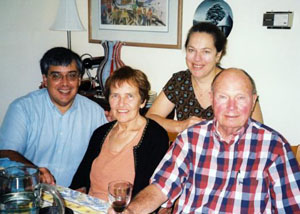
September
23/28. Syracuse. Peter & Denise Castro. Peter, a former student and now one of my
closest friends, joined the graduate programme at UCSB in 1978. I supervised
his dissertation, dealing with social forestry in Kenya. Peter was a Teaching
Assistant for the course that Bernard and I taught jointly – “Environmental
problems of the Third World”. When Bernard and I went to London with the
Education Abroad Programme in 1984/86, Peter took over our Environmental
Studies course, and in addition he and Denise were our house sitters. Peter has
stayed with us in London and he and Denise visited me Cape Town in December
2006. Peter is now a Professor in the department of anthropology at SU, while
Denise is a legal assistant. They live in Liverpool, NY, a few miles from SU.
Peter
and Denise collected me at the Thomas’ home in Ithaca, driving me first to the
famous Corning Glass Museum. We were intrigued by an elaborate exhibition,
“Glass of the Maharajahs”, showing the fantastic glass chandeliers and
furniture designed for Indian potentates in the mid-19th century. We went on to
the Rockwell Museum of Western Art which has some fine pieces by Alfred
Bierstadt, George Catlin, Frederic
Remington and others.
On
Sunday, Peter and Denise accompanied me to the 7:45am Mass, after which Peter
and I walked around Beaver Lake, a beautiful state park five miles away. For
the following four days of my stay, Peter and I walked every day round Beaver
Lake, choosing different routes, admiring the many waterbirds, and the trees
which were beginning to acquire their fall colours, and occasionally glimpsing
white-tailed deer. Over the next few days I met several of Peter's colleagues
from SU, including Micere Githae Mugo, a remarkable Kenyan woman who had been
imprisoned and tortured for criticising President Moi and who is now chairman
of African-American studies. Micere is the daughter and grand-daughter of
chiefs of the Ndia (Kikuyu), both of whom had fallen foul of colonial
authorities.
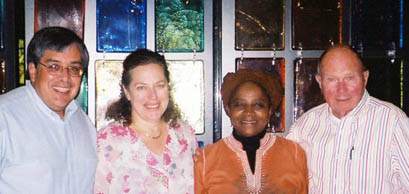 Peter, Denise, Misere &
DWB
Peter, Denise, Misere &
DWB
I talked to Peter’s Development Anthropology
seminar, which included nine graduate students from India, Swaziland, Uganda,
Ecuador, Tobago and the United States, most of them coming from public
administration. Being out of practice at lecturing, I was initially nervous,
but the students were so interested and responsive that I soon loosened up and
thoroughly enjoyed it. SU has a renowned collection of East African Archives,
including many government reports. At Peter's suggestion we searched for
documents from Handeni, Tanganyika, during my period there in the 1950s. We
found correspondence relating to the deposition of a corrupt chief, including a
letter signed by me in 1954, bringing back memories of my colonial days.
I read somewhere that “Buddha uses outrageous coincidences” and one of these occurred when Agnes Klingshirn, (whom I met in Ghana in 1962) arranged to attend an alternative energy conference in Syracuse – at precisely the time when I was staying with P & D. Peter and I drove to meet her; arriving early, Peter showed me the war memorial which included special plaques listing minority members who served in World War Two. In the same building an ice hockey game was in progress so Peter and I watched for a few minutes - for both of us this was our first live game, which was exciting and “balletic”. So that we could have a longer time together, Denise invited Agnes and her two colleagues to lunch (chile relleno and spicy cauliflower), a congenial group, with much to talk about . The Castros have two children: I did not see Camille who was away at Boston College preparing to take her law examination , but Denise drove me to Oswego College (on the shores of Lake Ontario) so that I could see Davy (another godson) whom we took out to dinner at an Italian restaurant. Despite Davy’s handicap of deafness, he is doing well in college and is a bright and interesting young man.
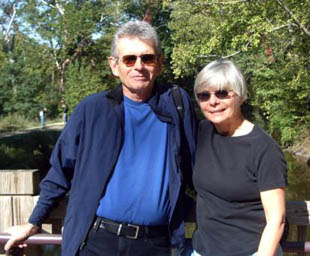 John & Carol
John & Carol
September 28/ October 1.
Washington DC, John and Carol Nellis. John and I met at SU in 1968, then we worked
together on the Special Rural Development Programme in Kenya 1970 - 71. John
(then on leave from the department of political science at SU) and I wrote a
joint article on local administration in Kenya; Bernard and I stayed several
times with the Nellis’ at their nice colonial home in Westlands, Nairobi. Once,
when John visited us in Mbeere, he and John Gerhart (both experienced birders)
and Bernard and I identified 45 different species in less than an hour. A heavy
rain shower was followed by the emergence of thousands of flying ants,
attracting countless birds, so intent on their prey that they ignored us During their stay in Nairobi their first
son Simon was born and I, as a conveniently accessible Catholic, was delighted
to be his godfather.
Simon
now lives in Prague , working as an analyst for a large bank; he was an
excellent guide to Bernard and me when we went to Prague in 1993; he married
Alice, a Czech film-maker, and they have a baby daughter, Ella Rose - whom John
and Carol dote on. Again and again
during my travels I appreciated the significance of grandparent/grandchildren
links. Their second son Jonathan spent two years as a Peace Corps volunteer in
Senegal; from there he came to Cape Town to join his parents on holiday.
Jonathan married Pamela, another Senegal Peace Corps volunteer; they now live
in Baltimore. With both sons away from home, much affection is shown to the two
cats, Lucca, a Siamese male and Katy the black cat. Told not to mind if Lucca
ignored me, I was inordinately pleased when he jumped on my lap and settled
down. John has recently retired from
the World Bank, and Carol is still working as a counsellor for the Secret
Service. Their home in Bethesda – at the end of the Metro line- is a delight;
since my last visit, many years ago, they have added a bright conservatory,
where we sat several times for coffee (John is a keen barrista) or tea ( I was introduced to a special gen mai tea), or wine.
I
knew John and Carol well enough to say that I wished to meet other friends
while I was in Washington DC , and that I would also like to visit the galleries.
Accordingly I arranged to meet Wilton and Virginia Dillon (with whom we
had overlapped at the University of Ghana in 1961/62) at the Cosmos Club -
described as “the meeting place for the intellectual elite”. I was impressed by
photographs, including a section of members who were Nobel Prize winners.
Wilton, who was for many years Director of Seminars at the Smithsonian
Institution, is a gracious and generous host, carefully choosing a Jindalee
Cabernet Sauvignon 2002 from Victoria; he has an endless supply of amusing
tales which always offer keen insights into the vagaries of human nature. He
also knows a large number of interesting and prominent people, and is a true
cosmopolitan.
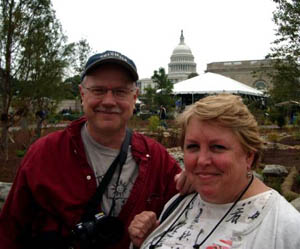 Tom & Miriam
Tom & Miriam
Miriam Chaiken and her husband Tom Conelly were graduate students at
UC S B who wrote their doctoral dissertations based on fieldwork in the
Philippines. They later did postgraduate research in Kenya where Bernard and I
met them at Lake Baringo, then visited them on the shores of Lake Victoria. And
in 2005 Miriam made a detour to see me in Cape Town when she was on her way to
a consultancy in Mozambique. They now
teach at Indiana University, Pennsylvania, where we had visited them; this was
too much out of the way for me, so they arranged to drive (4 or 5 hours) to
Washington DC to meet me. We had a good half-day together, visiting the new
National Garden on its first day of opening and wandering around the Botanic
Garden and then walking past the Capitol to lunch at a Union Station
restaurant. We had plenty of time to catch up on each other's lives.
The
Saturday evening mass in Bethesda was conducted by an uninspiring priest.
Fortunately John and Carol had invited lively friends for dinner that evening,
and their company fully compensated. Bernard and I always looked out for good
dessert wines, concluding that the best ever was the Californian Louis Martini Moscato Amabile, followed by the
Australian Hardy’s Noble Late Harvest;
John’s Muscat de Saint Jean de Minervois was also outstanding.
Among
the galleries that I visited was the National, where I much admired the Henri
Rousseau exhibition, Jungle in Paris.
John
and Carol are extremely fit, keen walkers and long-distance cyclists, so it was
easy to persuade them to take me to walk on the Chesapeake and Ohio Canal
towpath, on the River Potomac, where we saw many turtles and John identified the birds for me - it was a
lovely Sunday morning walk, with a festive air among the walkers and cyclists
on the path. After lunch (oysters and crab cake, with a Sancerre) on the patio of the Anglers
Inn, we drove to the Phillips Museum so that I could again admire Renoir's
magnificent, luminous Boating Party, and some new
acquisitions.

Although
I did not meet Simon and Jonathan, I was able to see and talk to them on the
video phone and I admired granddaughter Ella Rose in Prague. John is an
accomplished and spellbinding raconteur and Carol has an extremely wry humour,
plus keen insights. They were so hospitable and thoughtful. Here, as on my
other visits, I counted myself lucky to have such good friends: I was reminded
of Bernard, who used to ask in such situations , “what have we done to deserve
this?”
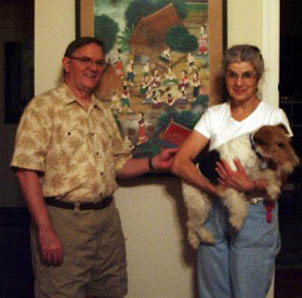 Ray & Susan
Ray & Susan
October
2/4. St Louis Missouri. Ray and Susan Scupin. From Bethesda I took a taxi
to National Airport for the early flight to St Louis. Ray joined the UCSB graduate programme in Anthropology in 1972,
after I, as departmental graduate advisor at that time, had interviewed him - and Susan - at UCLA.
He completed his PhD in 1978, writing a dissertation on Muslims in Thailand,
and for some years he has been teaching at Lindenwood, a small college near St Louis. Despite a heavy teaching
load, no sabbaticals, a conservative administration - Ray has been remarkably
productive, having written and edited several successful introductory books on
Anthropology. In looking at his books I was struck by the contrast with such
texts of 50 years ago. Ray’s books deal very much with the contemporary world -
with topics such as ethnicity, race, gender, poverty, environment and
globalisation; these are a far cry from what students were given in my time.
Then the introductory texts tended to deal with “other cultures”, often
depicting “the natives” as living in timeless, unchanging worlds.
Ray
and Susan (who trained in ethno-musicology, and who now works in the public
library) have an attractive large - 3500 square feet - home in St Charles, the
town centre of which has been lovingly restored and is now a major tourist
attraction. Ray’s air conditioned study, in the basement of his home, would be
the envy of any academic, being huge, with book shelves all round and ample
table space for computers and papers. Their two grown-up sons both live away
from home, but they share the house with their two thoroughbred wire-haired fox
terriers, Corkie and Robbie. They
have always liked this breed, and Ray was pleased when I told him about my
boyhood companion, Punch, a smooth haired fox terrier.
Ray
and Susan had taken the Monday off from work so they were able to show me
around, going first to the world famous Missouri Botanical Garden (which Bernard and I had visited in the
1970s). The garden had a fascinating exhibition, Glass in the Garden featuring, in the midst of the exotic plants, fantastic and colourful glass
works by Dale Chihuly, obviously a master in this field although I had never
heard of him. We went on to see Eero Saarinen’s Arch alongside the Missouri
river, taking a “tram” to the 620 ft high top for a splendid view of the city
and rivers. (St.Louis is at the junction of the Missouri and Mississippi Rivers
– Bernard had excitedly photographed the confluence as we flew overhead). At
the foot of the Arch is a small museum of the western United States, where we
watched a movie which realistically depicted the Lewis and Clark expedition of
1834. Back home I continued to enjoy the series of excellent meals when Susan
barbecued salmon, served with baked potato and salad and Lancers wine.
Ray
and Susan both worked on the Tuesday,
so Ray dropped me at the St Louis Art Museum. Arriving early, I sat on the
steps and watched a group of young women energetically getting their exercise
by running up a steep bank; the scene took me back 40 years when John Ostarello
used to encourage me to run up the steps of the stands at Berkeley. Nowadays I
am happy that I can just walk, briskly.
The
Art Museum, which housed the Universal exposition of 1904, has a wide
collection, very well arranged. I liked the German Expressionists of the 1920s
- Ernst Kirschner and Max Beckmann. American artists included George Caleb
Bingham and Thomas Eakins, and one of Monet’s Water Lilies series dominated an entire wall; Louis Comfort Tiffany
(1848 – 1933) was given a whole room to himself.
 Jolly Flatboatmen - Bingham
Jolly Flatboatmen - Bingham
St Louis Zoo, with its 11,000 animals and active
programmes in education and conservation, is a leader in the field, but I
settled for a tram ride around the zoo and a salad at the Cafe. It was a hot
day and I am not too happy to see animals in cages, even though I recognise the
value of zoos in today's world. I
walked across the park to the Missouri Historical Museum, where I spent a lot
of time in the section which dealt from 1764 (when Missouri was founded by the
French) to 1904. The presentation was admirable, looking at sensitive topics
like slavery, the civil war and western expansion. Obviously there had been
some recent rewriting of history, reminding me of the problems faced by
contemporary South African museums in trying to present a more balanced picture
of our history, without being trapped by Political Correctness. One placard
pointed out that the early pioneers had to ask themselves three basic
questions: How do we: provide for
ourselves? get along together, with each other? find a meaning in our lives? We
all need to ask such basic questions. Each display in this section offered an
informative five-minute video.
We
had a good dinner that evening at Spiro, where I was introduced to a new drink
- a Greek Margarita, with a dash of
Ouzo.
NEXT - Stage 5 California